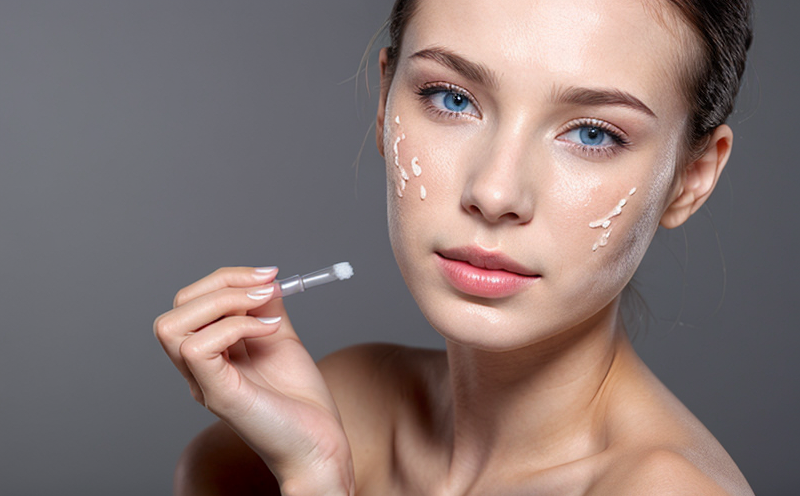Irritation Testing in Cold Creams and Balms
Testing for skin irritation is a critical aspect of ensuring cosmetic products are safe for consumers. Cold creams and balms, due to their high water content and emulsified nature, pose unique challenges that need to be addressed during testing. This service involves assessing the potential irritant properties of these formulations on human skin, using validated methods that align with international standards.
Our laboratory utilizes advanced techniques to simulate real-world conditions in which consumers might apply cold creams and balms. We employ both in vivo (live animal) and in vitro (cell-based or tissue culture) approaches tailored specifically for this category of cosmetic products. The in vivo testing typically involves a 4-hour patch test on guinea pigs, while the in vitro method uses human skin equivalents to assess irritation potential.
The primary focus is on identifying any adverse reactions such as erythema (redness), edema (swelling), and dermatitis (inflammation). Our laboratory adheres strictly to ISO 10763-2:2019, which provides comprehensive guidelines for the testing of skin irritancy. This ensures that our findings are reliable, reproducible, and comparable with other laboratories worldwide.
For products like cold creams and balms, it's essential to consider factors such as pH levels, preservative systems, and emulsifiers, all of which can influence how a product interacts with the skin. Preparing samples correctly is crucial; this includes homogenizing the cream thoroughly before applying it uniformly across the test area.
The use of advanced instrumentation like confocal microscopes helps in visualizing any inflammatory changes at microscopic levels. Additionally, we employ quantitative assays to measure the depth and extent of dermal involvement accurately. These detailed analyses provide a comprehensive picture of the product's safety profile.
Our team works closely with clients throughout the testing process, offering insights into potential issues early on. This collaborative approach ensures that any necessary adjustments can be made promptly, minimizing delays in bringing products to market.
The results from our irritation tests are detailed and comprehensive, providing clear recommendations for labeling and marketing purposes. Compliance officers benefit greatly from these reports as they help meet regulatory requirements set by various jurisdictions around the world. Quality managers gain valuable information about product stability and performance under different environmental conditions.
Scope and Methodology
| Test Parameter | Description |
|---|---|
| In Vivo Testing | Patch testing on guinea pigs for 4 hours to observe signs of irritation. |
| In Vitro Testing | Use of human skin equivalents to assess irritation potential without using animals. |
| Sample Preparation | Homogenization and uniform application across the test area. |
| Instrumentation | Confocal microscopes for visualizing microscopic changes; quantitative assays for measuring extent of injury. |
The methodology we follow is rooted in international standards such as ISO 10763-2:2019. This ensures that our testing procedures are consistent and aligned with global best practices. By adhering to these guidelines, we can provide clients with accurate and reliable data which is crucial for regulatory compliance.
Benefits
The benefits of undergoing irritation testing extend beyond mere compliance requirements; they offer significant advantages for both manufacturers and consumers alike:
- Safety Assurance: Ensures that the product does not cause adverse reactions, enhancing consumer trust.
- Regulatory Compliance: Meets stringent regulations imposed by health authorities worldwide.
- Risk Management: Identifies potential risks early in the development stage, allowing for timely corrective actions.
- Promotion of Innovation: Encourages safer formulation practices leading to better product quality.
In summary, irritation testing plays a vital role in safeguarding public health while fostering innovation within the cosmetic industry. By partnering with us, clients can rest assured knowing that their products are rigorously evaluated for safety and efficacy.
International Acceptance and Recognition
The results from our irritation testing laboratory are widely accepted across numerous countries and regulatory bodies due to our strict adherence to international standards. Regulatory agencies such as the FDA in the United States, EMA in Europe, TGA in Australia, and Health Canada recognize ISO 10763-2:2019-compliant studies.
Our testing protocols are designed to meet these stringent requirements ensuring that our clients can confidently present their findings to any regulatory body. The acceptance of our test data adds significant value to your product development process, speeding up the approval timeline and reducing costs associated with retesting or modifications.





